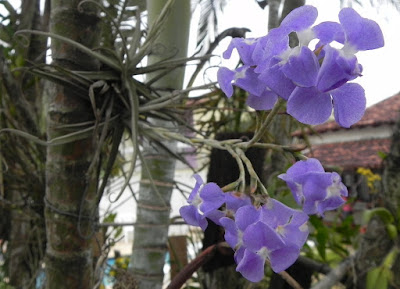Tillandsia streptocarpa is native to Bolivia, Peru, Argentina, Paraguay, and Brazil. It grows as either epiphytically among thorny shrubs in open woods in semi-arid regions or saxicolously in direct sunlight, or root on both trees and rocks at a single location at elevations of 60-2300 meters above sea level.
Tillandsia streptocarpa also called as Tillandsia duratii subsp. streptocarpa, Tillandsia soratensis, Tillandsia bakeriana, Tillandsia condensata, Tillandsia apoloensis, is a species of the genus Tillandsia. This species was described by John Gilbert Baker in 1887.
IDENTIFY TILLANDSIA STREPTOCARPA AIR PLANT
Tillandsia streptocarpa is native to Bolivia, Peru, Argentina, Paraguay, and Brazil. It grows as either epiphytically among thorny shrubs in open woods in semi-arid regions or saxicolously in direct sunlight, or root on both trees and rocks at a single location at elevations of 60-2300 meters above sea level.
It is an medium to large sized evergreen, caulescent, perennial plant, which reaching 60 cm when flowering, forming small clumps with silvery, elongate (up to 50 cm), relatively thick, slightly spread or curved leaves that are arranged helically around the stem and form a rosette.
This air plant blooms over an extended period mostly in autumn from the large, simple or bipinnate inflorescence, with in this case up to a dozen small linear spikes and separated from the axis which is visible, thin and quickly glabrous. The bracts of the flowering stem are similar to the leaves at the base of the inflorescence and shorter at the apex. The primary bracts are scaly, ribbed, short and similar to the highest bracts of the flowering stem. The floral bracts are pointed, glabrous or scaly.
The very fragrant flowers are non-tubular, more than 3 cm wide, violets (sometimes all white, or yellow for the aureiflora variety) with a lighter, almost white area in the center. Sepals free, 12 mm long, ecarinate, glabrous. The broad flared petals 23 mm long, claw linear, the blade broadly obovate, violet. The stamens and pistil are included.
This species is often confused with: Tillandsia arhiza (but leaves of Tillandsia streptocarpa are softer and sheaths often less colored), Tillandsia duratii (but Tillandsia. streptocarpa is much smaller, its leaves are upright, less drooping and have a finer tip and are not (or slightly) curved when they are older), Tillandsia reichenbachii (but leaves of Tillandsia streptocarpa are much softer, less "cylindrical" and especially larger (50 cm against only 15 cm for Tillandsia reichenbachii).
TILLANDSIA STREPTOCARPA AIR PLANT CARE AND CULTURE
Cultural information should only be used as a guide, and should be to be adapted to suit you. Your physical location; where you grow your plants, how much time you have to devote to their care, and many other factors, will need to be taken into account. Only then can you decide on the cultural methods that best suit you and your plants.
Light:
Tillandsia streptocarpa requires good light and enjoys full sun (avoid the afternoon in summer if the plant is young or has not been used). It is best placed in a sheltered spot in the garden during the summer to facilitate flowering.
Temperature:
The required temperature ranging from 10 to 32°C. Get it early enough in the fall if you grow it outside, so that it does not face night temperatures below 4 or 5 ° C, especially if it is wet. The plants can faced temperatures close to 0 ° C (sheltered and dry) for a few hours without damage.
Humidity:
This species need the low to moderate level of humidity. Good aeration is required, the plant must dry quickly (in less than an hour).
Substrate, growing media and repotting:
Tillandsia streptocarpa refer to be mounted on a solid substrate that does not retain water. You can glue the plant directly to the surface with a strong adhesive, or you can wire the plant to the base. Don't cover the base of the plant with moss or it may rot. It can be grown on almost any imaginable decorative mount, including shells, rocks, slate, driftwood, etc. Group them in decorative clumps for maximum effect.
Watering:
Twice a week in summer, once a week in winter according to the luminosity and the ambient humidity. Obviously when it rains and if you grow it outside, it counts as a watering. Water it every 2 days during the growing season if it is grown outdoors and the weather is dry.
Fertilizer:
This air plant can be fertilized with the moderate doses. 1 to 2 times a month in the summer and 1 time a month in the winter.

















COMMENTS